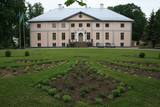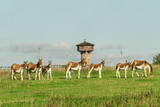| Нo | Название | Описание |
|---|---|---|
|
Гостевой дом Pinska – это семейное предприятие, стоящее на земле, ранее принадлежавшей сельской мызе Lõpinska. Из местных продуктов и в соответствии с местными традициями здесь готовят различные блюда. |
||
|
Durch das höchste Dünen-Massiv Estlands und den Moor führt der Lehr-Wanderweg. Blick vom Aussichtsturm bis auf die Insel Kihnu. |
||
|
В хозяйстве выращивают плодовые деревья и малину. Из разных ягод и плодов (малины, черной смородины, яблок) делают домашнее вино. Предлагают купить продукцию, а для интересующихся групп (до 25 человек) – дегустацию домашнего вина в обустроенном зале. |
||
|
Замок поместья Вилце возводили в середине 18 века (родовое имущество баронов Медемов) как охотничьий замок. Позже – в начале 19 века – его перестроили, построив второй этаж. В сводчатых погребах поместья находится кухня, где готовили еду и доставляли в верхние этажи на лифте. Входной портал в замок (позднее барокко) и мраморный рельеф над ним с гербами альянса Медемов и Кейзерлингов – это один из наиболее ценных памятников искусства такого типа в 18 веке. Сохранились также многочисленные хозяйственные постройки – овин, амбар и кузница, а также парк. Перед замком растет дуб, посаженный, возможно, К.Улманисом. В замке поместья с 1837 года расположилась начальная школа Вилцес. |
||
|
Находится на правом берегу реки Сакас – ул. Дзинтару, д. 1. Музей разместился в первом каменном здании Павилосты (из красных кирпичей и валунов) , которое было построено как лоцманский дом в 1879 году. Музейный фонд посвящен истории края и прибрежному рыболовству и мореходству. В качестве экспонатов представлены найденные в Сакской волости каменные и костяные топоры, кованые бронзовые сакты и пояса, а также уникальный экспонат - пресс для медовых сот. Рядом находится дом лодок с крупногабаритными экспонатами. В 2012 году открыта мансарда, где планируется проведение выставок и тематических мероприятий. + 371 63498276. Заслуживает внимания и старейшая часть Павилосты - Акьгалс, которая является типичным образцом застройки прибрежного поселка XIX – XX вв. |
||
|
The Baltic Sea littoral on the West coast of Kurzeme is called the Great Wave Sea. The seacoast is mainly sandy. While the Great Wave Sea section is the least populated coastal area in Latvia, at the same time, the third biggest city in Latvia, Liepāja, is also located there. Steep bluffs rise before your eyes on the seacoast between Pāvilosta and Sārnate. The villages are quiet and sparsely populated. At the beginning of the route, you can see the Soviet military heritage in Liepāja Karosta Prison, taste smoked local fish in Pāvilosta and then enjoy one of the most beautiful views of the entire route to the seacoast from Užava lighthouse. The route closes in the port city of Ventspils, where there are various entertainment and sightseeing places, especially for families with children. |
||
|
Auces novads miniatūrā izveidots ar Auces novada nozīmīgākajiem un atpazīstamākajiem objektiem miniatūrā, kuri apdzīvoti ar mājdzīvniekiem. Iespēja Auces novada iedzīvotājiem un viesiem izveidot saikni ar dabu un vienlaicīgi iepazīt Auces novadu. Mazajiem apmeklētājiem izglītojoša saikne ar dzīvniekiem, iespēja tos pabarot ar saimnieku sarūpētajām veltēm. Veicināta Auces novada atpazīstamība caur miniatūriem objektiem. Tiek piedāvāta ekskursija, kuras laikā iespējams apskatīt 4 saimniecības: Zemnieku saimniecību ‘’Skabargas”, Lauku sētu ‘’Krastiņos’’, saimniecību ‘’Andulaiši’ un Lauku sētu ‘’Baltiņi’’. Ekskursija notiek gida pavadībā. Tiek gaidīti viesi, grupās no 10 cilvēkiem, ar iepriekšēju pieteikšanos. |
||
|
1935. gadā Tūjā darbojās ķieģeļu ceplis, kas
ražošanā izmantoja apkārtnē esošās Devona perioda mālu iegulas.
1936. gadā uzsāka jaunās fabrikas celtniecību. Šeit ražoja arī augstas
kvalitātes ķieģeļus, ar kuriem tika apšūts arī Rīgas Pulvertornis. Tagad
fabrikas vietā ir pamests grausts, kas redzams no Tūjas centra, ejot jūras
virzienā.
|
||
|
Construction of the church began in 1830 thanks to money donated by nobleman Ludvigs Šabanskis. The Baroque stone church is surrounded by a restored stone fence, and inside there are icons including "Heart of Jesus," "Christ's Suffering," and "St Joseph." The church is not open to the public on a daily basis. |
||
|
Atrodas ceļa, kas ved uz Miķeļtorņa bāku – līkuma malā. Unikālā ēka (vienīgais lībiešu ciemu krogs ar raksturīgo plānojumu, kas saglabājies līdz mūsdienām) šobrīd atrodas avārijas stāvoklī un apskatāma tikai no ārpuses. Pizes krogs celts 1853. gadā. |
||
|
Te plašos aplokos mīt 38 sugu savvaļas dzīvnieki (kiangi, lāči, lūši, vilki, meža cūkas, aļņi, vāveres, plēsīgie putni) un visdažādāko šķirņu mājdzīvnieki – Latvijas zilās, Hailandes un Galovejas govis, Romanovas aitas, Vjetnamas cūkas, pīles, zosis, tītari u.c. Acīgākie dīķos pamanīs retās Eiropas kokvardes. Kalvenes pagasta „Cīruļi” – tā ir lieliska, nesteidzīga atpūta lauku vidē, iepazīstot dzīvo dabu! Darba laiks no novembra līdz martam: katru dienu no 10:00 – 16:00 |
||
|
В историческом ледовом погребе мызы Alatskivi делают вино, травяные чаи, съедобные сувениры, пряный уксус и варенье из урожая, собранного в окрестных лесах и полях. В уютном магазинчике можно продегустировать и купить вино, чаи и другие местные съедобные сувениры. Если Вы хотите навестить нас большой группой и в нерабочее время, то желательно сообщить о своем визите заранее. |
||
|
Во время этого тура вы узнаете о различных путях использования молока – либо для еды, либо для косметических процедур. Из Риги, через исторический и спа курорт Юрмалу, маршрут ведет на козью ферму, где вы попробуете сыры, а также эсклюзивное мороженое из козьего молока. Затем посетите Дундагский замок и попробуйте местные молочные продукты. В Рое познакомьтесь с местными традициями, отведайте рыбацкую еду и поучаствуйте в различных мероприятиях. Затем маршрут идет вдоль нетронутых песчаных пляжей мыса Колка к образцовому городу Вентспилсу, а оттуда поворачивает к живописной Кулдиге с ее хорошо сохранившимся деревянным зодчеством. Затем насладитесь красивым Поместьем Молока, где сможете опробовать разнообразные спа-процедуры на основе молока. Здесь же находится Музей Молока, где вы можете проследить за путем молока от коровы до стола, а также попробовать себя в выполнении различных работ, типа сбивания масла. А далее, маршрут становится сладким. Посетите конфетную фабрику в Салдус, где изготовляют вручную традиционные ириски. Затем в меню мороженое в Друве. Далее – осмотр достопримечательностей в Елгаве, которая когда-то была основным местонахожением герцога Курляндского. Посетите производителя сыров в Элея, а перед отъездом в Ригу посетите великолепный Рундальский дворец, который считается красивейшей жемчужиной Балтики. |
||
|
Название улица получила от рыбного рынка, который находился в конце улицы у площади Куршей. По адресу Рыбная улица 4/6, во дворе дома № 2 на соседней улице Пелду сохранились старые здания складов, построенные из цельных бревен. На Рыбной улице находится одна из самых популярных достопримечательностей города - Аллея славы Латвийских музыкантов (с 2006 года), на которой размещены 35 слепков рук Латвиийских музыкантов, вылитых из бронзы; выставлены 10 мемориальных досок, посвященных самым популярным музыкальным группам Латвии, а пять – уже ушедшим из жизни музыкантам. Там же находится самая большая гитара Латвии. |
||
|
Находится в живописном месте около Ругайского водохранилища. Хозяин выращивает и перерабатывает рыбу. Накрывает столы, на которых присутствуют латгальские блюда. Сотрудничает с крестьянами и рыбакам. Латышская кухня: Копченая рыба (карп, налим из Пейпуса, линь, сом, лещ). Консервы из леща. Из карпа, линя и леща варят рыбный суп. Крупяная каша с копченым мясом, приготовленный на месте ржаной хлеб и сыр. Особое блюдо: Суп-гуляш из линя. |
||
|
Хозяйка гостиницы "Роя" приглашает на пир! Для улучшения самочувствия здесь гостей встречают музыкой и «Дзимтените», затем – уха на костре, застольные песни и танцы. Наблюдение за процессом копчения рыбы и потчевание, пиво и березовый сок. Рассказ жен рыбаков о скландрауши (дижрауши) и процессе их приготовления, а также короткий экскурс в профессию рыбака. Покушать можно в ресторане «Отра пусе». Латышская кухня: Свежая рыба «Утренний улов», луковый суп в латышском вкусе, букстиньш, кровяная колбаса, копченая рыба, картофельные блины, десерт из ржаного хлеба, пиво, «Дзимтените», травяной чай, березовый сок, яблочный сидр. Особое блюдо: «Сделано в Рое» – рыбное ассорти из продукции края, «Скумбрия в Bokzālēs», «Творожная башенка в соусе из свежей клубники».
|
||
|
Ресторан «Тами - Тами» находится в центре города Елгавы в микрорайоне жилых домов, рядом с музыкальным клубом «Елгавас крекли» («Елгавские рубашки»). Известен интересным интерьером и организуемыми музыкальными и др. мероприятиями. Латышская кухня: Крестьянский омлет, свиная запеканка с лисичками и боровиками, рисотто из перловой крупы, клубничный суп с мороженым, тонкие блины. Особое блюдо: «Поцелуй Шарлотты» – слойка из яично-творожного крема и желе из сока. |
||
|
One of the largest karst areas in Estonia is found here. The unique Witch’s well is one of the most interesting parts of this area. During spring floods (not every year, and for only a short period of time), the well erupts with underground river waters to create an unusually powerful karst stream that can pump out as much as 100 litres per hour.
|
||
|
Ventspils Vecpilsētas vēsturiskais centrs. Nelielā Rātslaukuma (40 x 60 m) rietumu malā atrodas Starptautiskā rakstnieku un tulkotāju māja, kas ierīkota 18. gs. dzīvojamā ēkā ar baroka un klasicisma iezīmēm (19. gs. vidū te atradās pilsētas Rātsnams), bet austrumu malā – vēlīnā klasicisma stilā celtā evaņģēliski luteriskā Nikolaja baznīca. Iepretim baznīcai atrodas modernā stilā pārbūvētā Ventspils Galvenā bibliotēka un Digitālais centrs, kas ierīkots greznā 19. gs. savrupmājā. |
||
|
Расположен в 1,3 км к северо-западу от центра Акнисте, в небольшом отвершке Диенвидсусеи. Этот родник как источник здоровья известен с древнейших времен. Рассказывают, что в роднике, вытекающем на восток, вода обладает целительными свойствами. Особенно утром на Пасху, если помыть глаза. Родниковая вода содержит соединения железа, о чем свидетельствуют коричневые наросты (результат воздействия железобактерий). Рядом с родником есть камень с небольшим углублением, предположительно - старинный культовый камень. На краю оврага растет святая липа. Святой источник Салтупе можно обоснованно считать одним из самых значимых родников Латвии. |
||
























